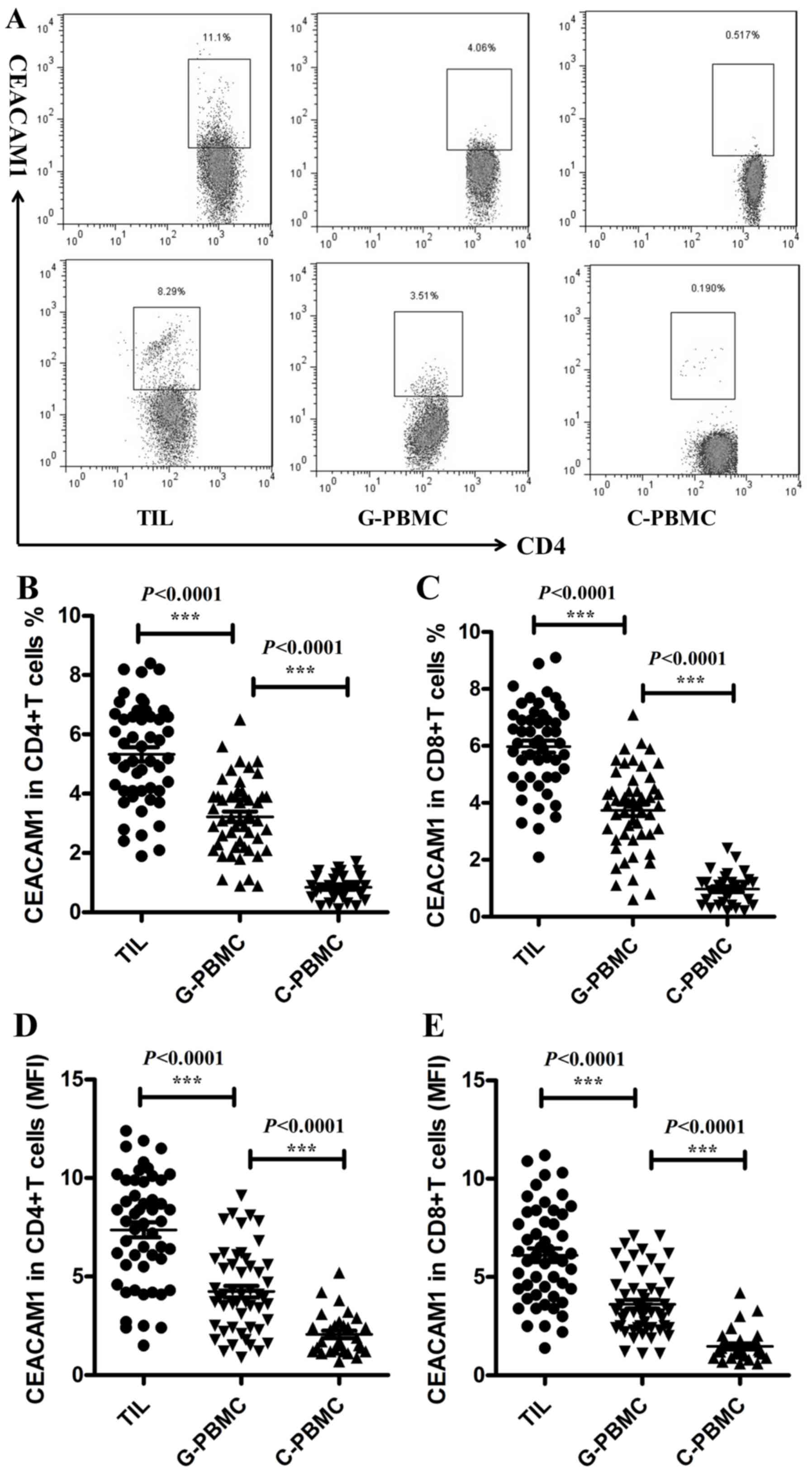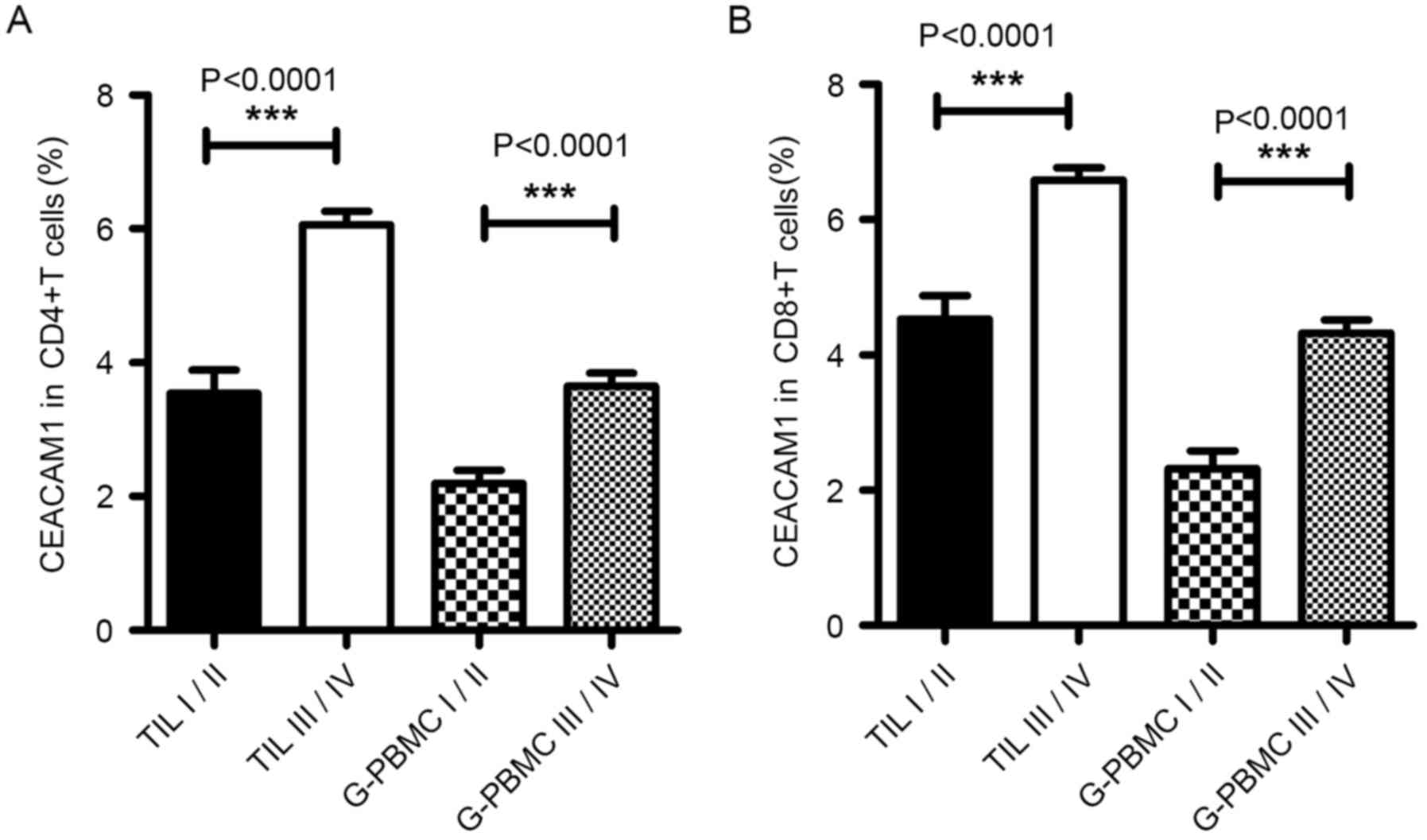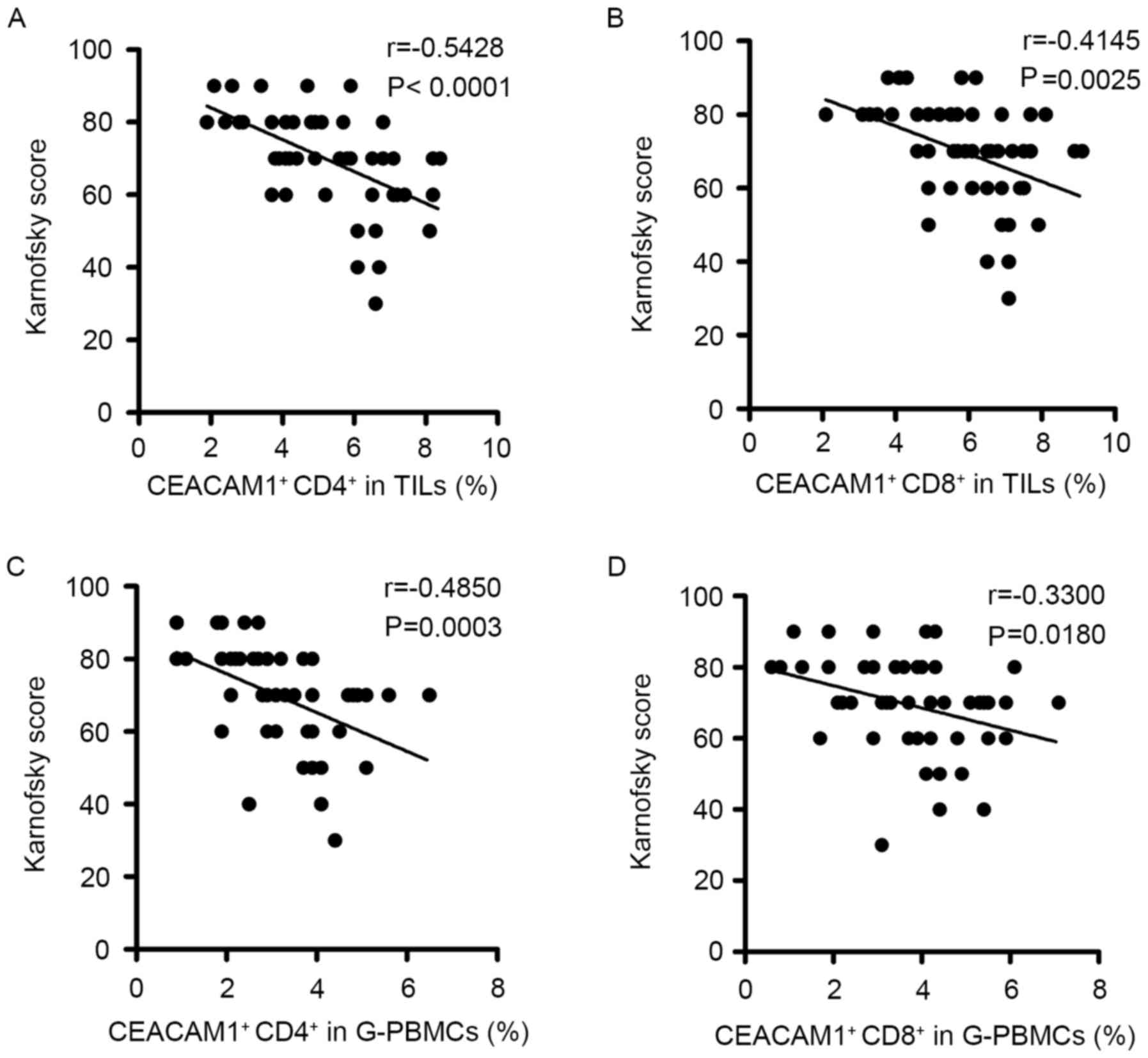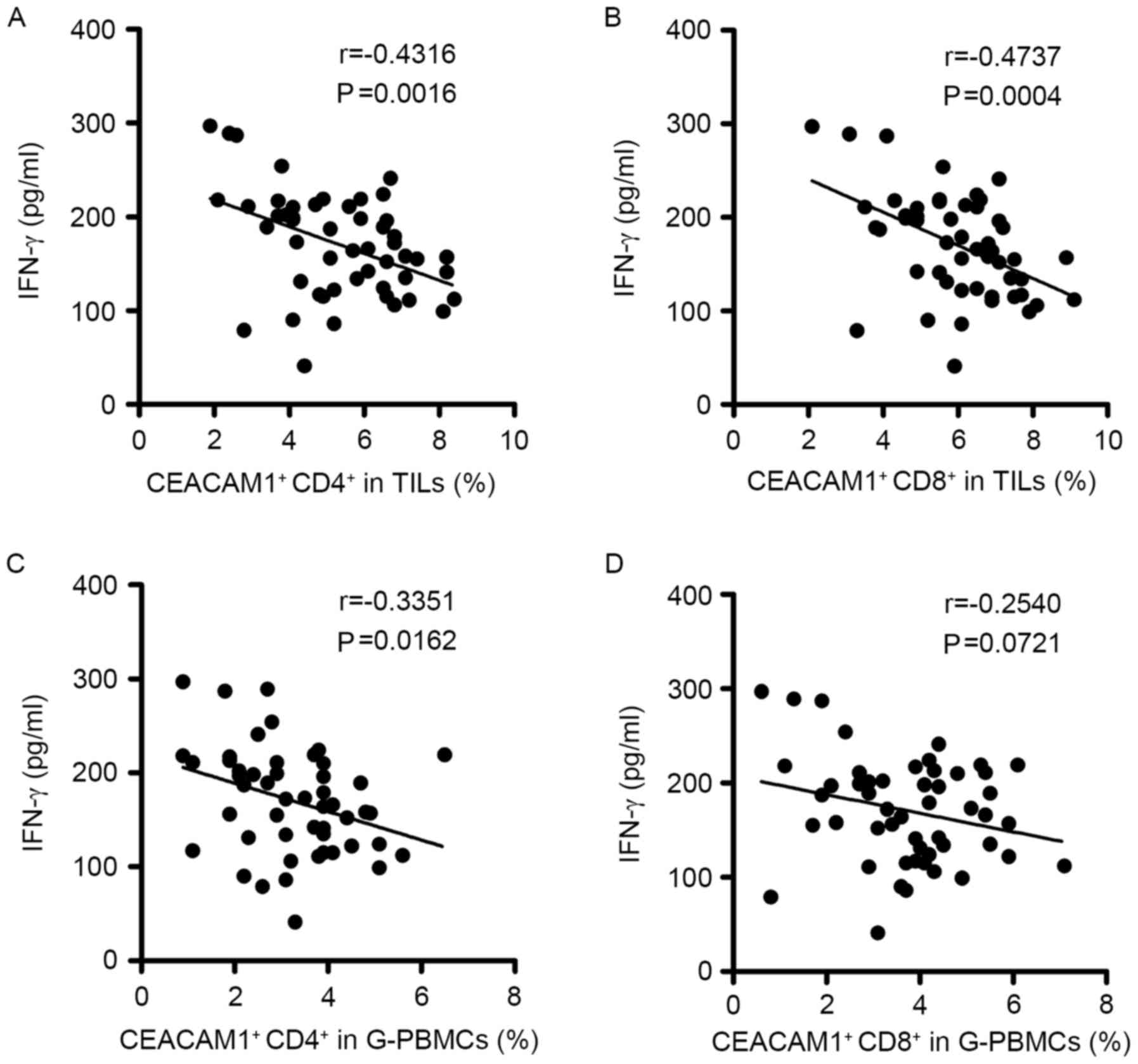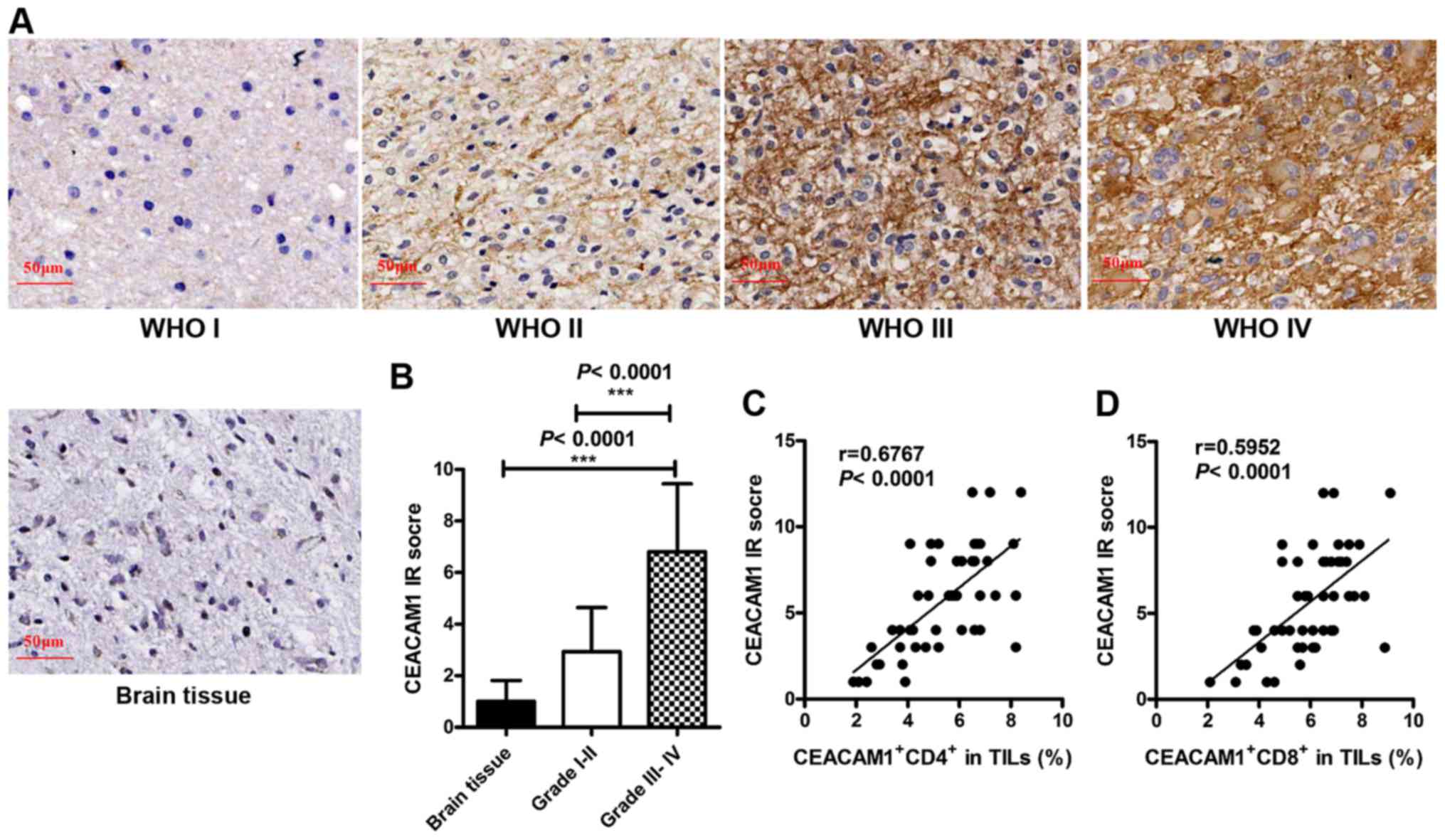Abnormal expression of circulating and tumor-infiltrating carcinoembryonic antigen-related cell adhesion molecule 1 in patients with glioma
- Authors:
- Published online on: January 12, 2018 https://doi.org/10.3892/ol.2018.7786
- Pages: 3496-3503
-
Copyright: © Li et al. This is an open access article distributed under the terms of Creative Commons Attribution License.
Abstract
Introduction
Glioma is the most prevalent and lethal primary brain tumor in adult humans and is characterized by excessive tumor proliferation, diffused infiltration and immunosuppression (1,2). Although patients with malignant gliomas undergo aggressive treatment, for example surgical resection combined with radiotherapy and chemotherapy, high rates of morbidity and mortality continue to prevail. For glioblastomas in particular, the overall survival period is only ~15 months post-diagnosis (3). Therefore, there is an imperative requirement to develop novel therapeutic strategies and identify more specific biomarkers for the diagnosis and treatment of gliomas. Immunotherapeutic strategies have garnered increasing attention as a potential treatment approach for gliomas.
Carcinoembryonic antigen-related cell adhesion molecule 1 (CEACAM1) is expressed on the surface of a wide variety of epithelial cells and immune cells. CEACAM1 is considered to be a specific biomarker, associated with tumor progression, metastasis and poor prognosis (4–6). Additionally, previous studies have demonstrated that CEACAM1 is an immune checkpoint regulator expressed on the surface of effector immune cells, and is considered to be a crucial molecule in the downregulation of immune responses (7,8). CEACAM1 may inhibit cytotoxicity and attenuate antitumor immunity in natural killer (NK) cells (9,10). Coincidentally, CEACAM1-silenced tumor cells exhibit a greater sensitivity to the cytotoxic effects of NK cells (11). Furthermore, it has been demonstrated that antitumor effects may be enhanced in malignant melanoma using monoclonal antibodies to block the inhibitory CEACAM1 pathway (12). Notably, a combined treatment of cytokine-induced killer cells (CIK) with CEACAM1-specific antibodies has demonstrated an enhanced therapeutic efficacy in patients with lung cancer compared with CIK therapy alone (13). Thus, CEACAM1 may be a promising target candidate for tumor immunotherapies.
Homophilic interactions of CEACAM1, occurring between CEACAM1+ tumor-infiltrating lymphocytes (TILs) and CEACAM1+ tumor cells, may inhibit multiple effector functions of TILs (8,14,15). Therefore, tumors may adopt certain mechanisms that utilize key immune checkpoint molecules in order to avoid immunological attacks (16). In fact, gliomas may form an immunosuppressive environment that inhibits the antitumor immune response through the dysregulated expression of inhibitory immune checkpoint molecules [including B7-H3 (17,18), galectin-9 (19) and programmed death ligand 1 (20)] on the cell surface. These studies imply that the immune checkpoint regulation performed by CEACAM1 homophilic interactions may serve a pivotal function in the downregulation of immunological responses to tumors and may influence the progression of tumors.
However, currently, to the best of our knowledge, there have been no studies investigating the function of CEACAM1 as an immune checkpoint molecule in the immune microenvironment of gliomas. In the present study, the expression levels of CEACAM1 in T cells and tumor tissues, and their association with various clinicopathological characteristics in patients with gliomas, were assessed.
Materials and methods
Characteristics of the study population
A total of 51 glioma tissues and peripheral blood samples were obtained from patients with glioma at the First Hospital of Shanxi Medical University (Taiyuan, China) between May 2013 and March 2016. All the patients were newly diagnosed and confirmed as patients with gliomas through histopathological examination and had not received any tumor treatment prior to surgical operation. The glioma tissues were pathologically graded according to the World Health Organization (WHO) classification of the central nervous system tumors (21). Patients with other diseases were excluded, including those with severe infections and other types of tumor. The clinical information of patients with gliomas was obtained from their medical records. All the healthy control subjects were matched with the patients with gliomas according to sex and age. Additionally, 10 non-tumorous brain tissues, obtained from patients with severe craniocerebral injuries who were undergoing surgical treatment, were selected as control tissues. All participants provided written informed consent, and the present study was approved by the Clinical Research Ethics Committee of Shanxi Medical University (Taiyuan, China).
Flow cytometry
TILs were separated from fresh glioma tissues, as follows. Tumor tissues were minced with sterile tissue scissors, and then digested with collagenase IV (Invitrogen; Thermo Fisher Scientific, Inc., Waltham, MA, USA), hyaluronidase (Shanghai Seebio Biological Technology Co., Ltd., Shanghai, China) and DNase I (Zhejiang Ontores Biotechnologies Co., Ltd., Zhejiang, China) in sterile PBS (Wuhan Boster Biological Technology, Ltd., Wuhan, China), at 37°C for 45 min. The digested tissues were filtered using a 100 µm stainless steel filter, and the resulting cells were separated with Percoll solution (Sigma-Aldrich; Merck KGaA, Darmstadt, Germany) at 800 × g for 20 min at room temperature. Mononuclear cells were isolated from venous blood using Ficoll density gradient centrifugation (Tianjin Haoyang Biological Products Technology Co., Ltd., Tianjin, China), according to the manufacturer's instructions. Cells were incubated at 4°C for 30 min in a dark room with the following monoclonal antibodies: Phycoerythrin/cyanine-5-conjugated anti-human cluster of differentiation 3 (CD3) (cat. no. 15-0038-42, 6 µg/ml−1; eBioscience; Thermo Fisher Scientific, Inc.), allophycocyanin-conjugated anti-human CD4 (cat. no. 17-0049-42, 50 µg/ml−1; eBioscience; Thermo Fisher Scientific, Inc.), fluorescein isothiocyanate (FITC)-conjugated anti-human CEACAM1 (cat. no. sc-70450, 100 µg/ml−1; Santa Cruz Biotechnology, Inc., Dallas, TX, USA), and FITC-conjugated mouse immunoglobulin G1κ isotype control antibody (cat. no. 11-4714-41; 100 µg/ml−1; eBioscience; Thermo Fisher Scientific, Inc.). In total, ≥10,000 cells were collected and analyzed using a BD FACSCanto™ II flow cytometer (BD Biosciences, Franklin Lakes, NJ, USA). The data were analyzed using FlowJo software (version 5.0; FlowJo, LLC, Ashland, OR, USA).
ELISA
Venous blood was centrifuged at 800 × g for 8 min at room temperature. Plasma was collected and stored at −80°C in a freezer. The concentrations of interferon (IFN)-γ (pg/ml) were identified using an ELISA kit (cat. no. EK0373; Wuhan Boster Biological Technology, Ltd.), according to the manufacturer's instructions.
Immunohistochemistry (IHC)
A total of 51 glioma tissues and 10 non-tumorous brain tissues were collected. The formalin-fixed and paraffin-embedded tissues were cut into sections 3–4 µm thick. CEACAM1 expression was determined using the streptavidin-biotin complex IHC method using a diaminobenzidine kit (cat. no. AR1000; Wuhan Boster Biological Technology, Ltd.), according to the manufacturer's instructions. Tissue sections were incubated with rabbit anti-human CEACAM1 monoclonal antibody at 37°C for 2 h. (dilution 1:100, cat. no. EPR4048; Abcam, Cambridge, UK). Sections were viewed in five random fields at ×400 magnification, using light microscopy, and the positive rate and staining intensity of CEACAM1 were analyzed using the Aperio Digital Pathology Slide Scanner (Leica Microsystems, Inc., Buffalo Grove, IL, USA). CEACAM1 expression was scored using the immunoreactive scoring (IRS) method, according to the distribution and staining intensity. IRS = percentage of positive cells (PP) × staining intensity (SI). The PP was scored as follows: 0%, 0; 0–25%, 1; 25–50%, 2; 50–75%, 3; and 75–100%, 4. The SI was determined as follows: Absent, 0; weak, 1; moderate, 2; and strong, 3 (19).
Statistical analyses
Statistical analyses were performed using GraphPad Prism (version 5.0; GraphPad Software Inc., La Jolla, CA, USA) and SPSS (version 19.0; IBM Corp, Armonk, NY, USA). Data are presented as the mean ± standard error of the mean. Analysis of variance with Kruskal-Wallis and Nemenyi post hoc tests, and Spearman's correlation analysis were used to analyze the differences and correlations, respectively, between the different study groups. P<0.05 was considered to indicate a statistically significant difference.
Results
Characteristics of the study population
In total, 51 patients with glioma and 30 healthy control subjects were selected. Their clinical and pathological characteristics are presented in Table I. Patients with glioma and the control subjects did not significantly differ in age or sex (P>0.05). According to the WHO classification of glioma grades, patients with glioma were classified as follows: Four grade I patients; 11 grade II patients; 26 grade III patients; and 10 grade IV patients. According to the clinical records, the Karnofsky scores (22) of patients with glioma were calculated as follows: ≥80, 19 individuals; 60–80, 25 individuals; and <60, 7 individuals.
Increased expression of CEACAM1 on peripheral and tumor-infiltrating T cells in patients with glioma
To determine the function of CEACAM1 in gliomas, the expression of CEACAM1 on PBMCs and TILs obtained from patients with gliomas and PBMCs obtained from control subjects were analyzed using flow cytometry. As presented in Fig. 1A and B, significant increases in the proportion of CEACAM1+ cells were observed among CD4+ T cells (TILs, 5.33±0.24%, n=51; patient PBMCs, 3.22±0.17%, n=51; control PBMCs, 0.84±0.08%, n=30; P<0.0001) and among CD8+ T cells (Fig. 1C; TILs, 5.98±0.21%, n=51; patient PBMCs, 3.74±0.20%, n=51; control PBMCs, 0.97±0.10%, n=30; P<0.0001) in PBMCs of patients with glioma, and this percentage was increased further in TILs of patients with glioma. Similar results were observed when the mean fluorescence intensity (MFI) of CEACAM1 on CD4+T cells (Fig. 1D; TILs, 7.37±0.39%, n=51; patient PBMCs, 4.24±0.29%, n=51; control PBMCs, 2.07±0.41%, n=30; P<0.0001) and CD8+ T cells (Fig. 1E; TILs, 6.11±0.34%, n=51; glioma patient PBMCs, 3.62±0.23%, n=51; control PBMCs, 1.47±0.15%, n=30; P<0.0001) was analyzed. The increased expression of CEACAM1 on T cells may indicate that CEACAM1 participates in the tumorigenesis of gliomas.
Expression of CEACAM1 on T cells is associated with different glioma grades
The WHO classification of glioma grades is based on the malignancy of the tumors and is broadly used as a prognostic factor for gliomas. High-grade gliomas (WHO grade III–IV) are poorly differentiated or undifferentiated, progress rapidly and are associated with a poorer overall survival rate, compared with low-grade gliomas. The association between the expression of CEACAM1 on T cells and different glioma grades among patients was analyzed. As presented in Fig. 2A and B, expression of CEACAM1 on the CD4+ T cells (glioma grade I–II, 2.20±0.20%, n=15; glioma grade III–IV, 3.65±0.19%, n=36; P<0.0001) and CD8+ T cells (glioma grade I–II, 2.32±0.27%, n=15; and glioma grade III–IV, 4.33±0.19%, n=36; P<0.0001) in PBMCs was significantly increased in high-grade gliomas compared with low-grade gliomas; the expression of CEACAM1 on CD4+ T cells (glioma grade I–II, 3.55±0.34%, n=15; glioma grade III–IV, 6.07±0.20%, n=36; P<0.0001) and CD8+ T cells (glioma grade I–II, 4.53±0.34%, n=15; glioma grade III–IV, 6.59±0.18%, n=36; P<0.0001) was further increased in TILs, suggesting that the proportion of CEACAM1+ T cells in patients with glioma was associated with the WHO grade of the glioma. These results indicated that the expression levels of CEACAM1 in T cells were associated with the glioma grade and that CEACAM1 may be used as a specific biomarker for the prognosis of glioma.
Expression of CEACAM1 on T cells is negatively correlated with different Karnofsky scores in patients with glioma
The Karnofsky score is widely used to assess the severity of the cancer in patients; a lower Karnofsky score indicates poorer prognosis (23). The correlation between the expression of CEACAM1 on T cells in patients with glioma and their Karnofsky scores was analyzed (Fig. 3). The results revealed that the frequencies of CEACAM1 expressed on CD4+ T cells (TILs, r=−0.5428, P<0.0001; PBMCs, r=−0.4850, P=0.0003; Fig. 3A and C, respectively) and CD8+ T cells (TILs, r=−0.4145, P=0.0025; PBMCs, r=−0.3300, P=0.0180; Fig. 3B and D, respectively) in TILs and PBMCs were negatively correlated with the Karnofsky scores of patients with glioma. These data suggested that the expression levels of CEACAM1 on T cells may be significantly associated with the severity of the glioma.
Expression of CEACAM1 is negatively correlated with the plasma IFN-γ level in patients with glioma
IFN-γ is secreted by activated immune cells and serves a vital function in antitumor immunity (24). Therefore, the plasma IFN-γ levels of patients with glioma was analyzed using an ELISA (Fig. 4). The data indicated that plasma IFN-γ levels were negatively correlated with the expression of CEACAM1 on CD4+ T cells in TILs (r=−0.4316, P=0.0016; Fig. 4A) and PBMCs (r=−0.3351, P=0.0162; Fig. 4C). CEACAM1+ CD8+ T cells in TILs were also negatively correlated with the plasma IFN-γ levels of patients with glioma (r=−0.4737, P=0.0004; Fig. 4B), whereas those in PBMCs did not demonstrate any significant correlation with IFN-γ levels in serum (r=−0.2540, P=0.0721; Fig. 4D). In general, these data demonstrated that the expression levels of CEACAM1 in the T cells of patients with glioma were associated with the antitumor factor IFN-γ, and indicated that increased CEACAM1 expression may have a negative regulatory effect on T cells by suppressing the IFN-γ-secreting capability of T cells.
CEACAM1 expression in glioma tissues is positively associated with the proportion of CEACAM1+ T cells in TILs and the glioma grade
Homophilic interactions of CEACAM1 may occur between CEACAM1+ TILs and CEACAM1+ tumor cells, which leads to the apoptosis of CEACAM1+ T cells (8,14). Thus, the homophilic interactions of CEACAM1 may serve a pivotal function in immunosuppression. To assess the importance of CEACAM1 homophilic interactions in gliomas, further investigations were made into the expression of CEACAM1 in glioma tissues and the control brain tissues using IHC analysis. Negligible or no staining of CEACAM1 in the control brain tissues was observed; however, an increased positive expression of CEACAM1 was observed in the tumor tissues of patients with glioma following IHC staining (Fig. 5A). Additionally, IRS was used (based on the distribution and intensity of CEACAM1 staining) to score the expression levels of CEACAM1. The data revealed that in patients with glioma, the expression levels of CEACAM1 in tumor tissues were associated with the grade of the glioma. Compared with control brain tissues, CEACAM1 expression in grade III–IV glioma was increased; however, the difference was not statistically significant in grade I–II glioma (brain tissue, 1.000±0.25822, n=30; glioma grade I–II, 2.933±0.4415, n=15; P=0.003; glioma grade III–IV, 6.806±0.4397, n=36; P<0.0001; Fig. 5B). Furthermore, CEACAM1 expression in tumor tissues was positively correlated with the proportion of CEACAM1+ CD4+ T cells (r=0.6767, P<0.0001; Fig. 5C) and CEACAM1+ CD8+ T cells in TILs (r=0.5952, P<0.0001; Fig. 5D). These observations suggested that the expression of CEACAM1 on T cells and glioma cells was increased, indicating that the homophilic interactions of CEACAM1 may be crucial in the development and progression of gliomas.
Discussion
CEACAM1 serves a crucial function in immune regulation and the evasion of immune surveillance. However, the effects of CEACAM1 on the immunoenvironment of gliomas had not previously been investigated. In the present study, the expression levels of CEACAM1 in glioma were determined and the association between CEACAM1 expression and multiple clinicopathological parameters in patients with glioma were analyzed. To the best of our knowledge, the results of the present study provide the first evidence indicating that CEACAM1 homophilic interactions participate in the development and progression of gliomas, potentially by regulating CD4+ and CD8+ T cell subsets.
Glioma cells may evade immune surveillance and escape immune attacks by creating immunosuppressive environments (25). One of the key mechanisms for immunosuppression involves the upregulated expression of immune checkpoint molecules [including programmed death ligand 1, cytotoxic T lymphocyte-associated antigen-4, and CEACAM1 (26–28)] on activated TILs. The dysregulated expression of CEACAM1 in tumors is a key factor in the immune interaction between tumor cells and lymphocytes. This interaction inhibits T cell-mediated immunological cytotoxicity, which protects tumor cells from immune attacks (8). Additionally, blocking the CEACAM1 signaling pathway using specific monoclonal antibodies has been demonstrated to be a promising method for reversing the immune resistance of tumors (12). The results of the present study identified that the expression levels of CEACAM1 were increased in circulating CD4+ and CD8+ T cells compared with those in control subjects, and further increased in the CD4+ and CD8+ T cells in tumor tissues of patients with glioma. Additional results include that the expression of CEACAM1 on T cells in patients with high-grade glioma was increased further compared with that in patients with low-grade glioma. IHC analysis revealed that CEACAM1 expression was increased in glioma tissues compared with that in brain tissues of control subjects, and the expression further increased in high-grade gliomas. Taken together, these results suggested that CEACAM1 may be a potential biomarker for the prognosis of glioma, and the homophilic interactions of CEACAM1 may be involved in the development of gliomas.
The Karnofsky score is a standard and practical method for evaluating the severity of the tumors in patients with glioma, and a lower Karnofsky score indicates a shorter survival time for the patients (23). The present study analyzed the association between the expression of CEACAM1 on T cells and the Karnofsky scores of the patients with glioma. Notably, a significantly negative correlation was observed between Karnofsky scores and the expression of CEACAM1 on T cells. Thus, the results of the present study indicated that CEACAM1 may be associated with the severity of the glioma. IFN-γ is a major pro-inflammatory cytokine in antitumor immune responses that may be secreted by activated T lymphocytes. It has been reported that IFN-γ may enhance antitumor effects and be used in therapeutic approaches to treat tumors (24,29). The results of the present study revealed that the plasma level of IFN-γ in the venous blood was negatively correlated with the expression of CEACAM1 on CD4+ and CD8+ T cells in TILs and peripheral CD4+ T cells in patients with glioma, indicating that CEACAM1 may inhibit antitumor immune responses by downregulating IFN-γ.
The results of the present study were similar to the results of previous studies on another important immune checkpoint protein, T-cell immunoglobulin and mucin-domain containing-3 (Tim-3) in glioma (19,30). Notably, CEACAM1 has been identified as a heterophilic ligand for Tim-3, and may regulate Tim-3-mediated immune tolerance and exhaustion of T cells. The co-blockade of CEACAM1 and Tim-3 resulted in a synergistic therapeutic effect in mouse colorectal cancer models (31). Collectively, these results, together with those of the present study, suggest that homophilic or heterophilic interactions in CEACAM1 and Tim-3 may serve an important function in gliomas via numerous different immunological mechanisms.
Immunotherapy has emerged as a promising approach for the treatment of gliomas. Nevertheless, the mechanisms by which gliomas evade immunological surveillance and escape immunological attacks remain unknown. In the present study, the expression of CEACAM1 on CD4+ and CD8+ T cells in PBMCs and TILs, and in glioma tissue were assessed. Furthermore, the associations between the CEACAM1 homophilic interactions, tumor progression and multiple clinicopathological parameters in patients with glioma were analyzed. To the best of our knowledge, the results of the present study provide direct evidence for the first time that CEACAM1 participates in the progression of glioma by regulating CD4+ and CD8+ T cells, and that it may be a promising diagnostic biomarker and a therapeutic target for glioma immunotherapies.
Acknowledgements
The present study was supported by the National Natural Science Foundation of China (grant no. 81470115), the Science and Technology Research Program of Shanxi Province (grant no. 2015025), the Basic Research Program of Shanxi Province (grant no. 201601D011102) and the Graduate Student Education Innovation Program of Shanxi Province (grant no. 2016BY081).
Glossary
Abbreviations
Abbreviations:
|
CEACAM1 |
carcinoembryonic antigen-related cell adhesion molecule 1 |
|
TILs |
tumor-infiltrating lymphocytes |
|
PBMCs |
peripheral blood mononuclear cells |
|
WHO |
World Health Organization |
References
|
Porter KR, Mccarthy BJ, Freels S, Kim Y and Davis FG: Prevalence estimates for primary brain tumors in the United States by age, gender, behavior, and histology. Neuro-Oncology. 12:520–527. 2010. View Article : Google Scholar : PubMed/NCBI | |
|
Pan J, Zhao X, Lin C, Xu H, Yin Z, Liu T and Zhang S: Immune responsive gene 1, a novel oncogene, increases the growth and tumorigenicity of glioma. Oncol Rep. 32:1957–1966. 2014. View Article : Google Scholar : PubMed/NCBI | |
|
Stupp R, Mason WP, van den Bent MJ, Weller M, Fisher B, Taphoorn MJ, Belanger K, Brandes AA, Marosi C, Bogdahn U, et al: Radiotherapy plus concomitant and adjuvant temozolomide for glioblastoma. N Engl J Med. 352:987–996. 2005. View Article : Google Scholar : PubMed/NCBI | |
|
Wang N, Feng Y, Wang Q, Liu S, Xiang L, Sun M, Zhang X, Liu G, Qu X and Wei F: Neutrophils infiltration in the tongue squamous cell carcinoma and its correlation with CEACAM1 expression on tumor cells. PLoS One. 9:e899912014. View Article : Google Scholar : PubMed/NCBI | |
|
Kiriyama S, Yokoyama S, Ueno M, Hayami S, Ieda J, Yamamoto N, Yamaguchi S, Mitani Y, Nakamura Y, Tani M, et al: CEACAM1 long cytoplasmic domain isoform is associated with invasion and recurrence of hepatocellular carcinoma. Ann Surg Oncol. 21 Suppl 4:S505–S514. 2014. View Article : Google Scholar : PubMed/NCBI | |
|
Dupuis ML, Fiori V, Soriani A, Ricci B, Dominici S, Moricoli D, Ascione A, Santoni A, Magnani M and Cianfriglia M: The human antibody fragment DIATHIS1 specific for CEACAM1 enhances natural killer cell cytotoxicity against melanoma cell lines in vitro. J Immunother. 38:357–370. 2015. View Article : Google Scholar : PubMed/NCBI | |
|
Markel G, Sapir Y, Mandel I, Hakim M, Shaked R, Meilin E, McClanahan T, Loboda A, Hashmueli S and Ben Moshe T: Inhibition of the novel immune checkpoint CEACAM1 to enhance anti-tumor immunological activity. J Clin Oncol. 34:2016. | |
|
Markel G, Seidman R, Stern N, Cohen-Sinai T, Izhaki O, Katz G, Besser M, Treves AJ, Blumberg RS, Loewenthal R, et al: Inhibition of human tumor-infiltrating lymphocyte effector functions by the homophilic carcinoembryonic cell adhesion molecule 1 interactions. J Immunol. 177:6062–6071. 2006. View Article : Google Scholar : PubMed/NCBI | |
|
Markel G, Lieberman N, Katz G, Arnon TI, Lotem M, Drize O, Blumberg RS, Bar-Haim E, Mader R, Eisenbach L and Mandelboim O: CD66a interactions between human melanoma and NK cells: A novel class I MHC-independent inhibitory mechanism of cytotoxicity. J Immunol. 168:2803–2810. 2002. View Article : Google Scholar : PubMed/NCBI | |
|
Hosomi S, Chen Z, Baker K, Chen L, Huang YH, Olszak T, Zeissig S, Wang JH, Mandelboim O, Beauchemin N, et al: CEACAM1 on activated NK cells inhibits NKG2D-mediated cytolytic function and signaling. Eur J Immunol. 43:2473–2483. 2013. View Article : Google Scholar : PubMed/NCBI | |
|
Chen Z, Chen L, Baker K, Olszak T, Zeissig S, Huang YH, Kuo TT, Mandelboim O, Beauchemin N, Lanier LL and Blumberg RS: CEACAM1 dampens antitumor immunity by down-regulating NKG2D ligand expression on tumor cells. J Exp Med. 208:2633–2640. 2011. View Article : Google Scholar : PubMed/NCBI | |
|
Ortenberg R, Sapir Y, Raz L, Hershkovitz L, Ben Arav A, Sapoznik S, Barshack I, Avivi C, Berkun Y, Besser MJ, et al: Novel immunotherapy for malignant melanoma with a monoclonal antibody that blocks CEACAM1 homophilic interactions. Mol Cancer Ther. 11:1300–1310. 2012. View Article : Google Scholar : PubMed/NCBI | |
|
Zhang L, Wang J, Wei F, Wang K, Sun Q, Yang F, Jin H, Zheng Y, Zhao H, Wang L, et al: Profiling the dynamic expression of checkpoint molecules on cytokine-induced killer cells from non-small-cell lung cancer patients. Oncotarget. 7:43604–43615. 2016.PubMed/NCBI | |
|
Li Y and Shively JE: CEACAM1 regulates Fas-mediated apoptosis in Jurkat T-cells via its interaction with β-catenin. Exp Cell Res. 319:1061–1072. 2013. View Article : Google Scholar : PubMed/NCBI | |
|
Grayowen SD and Blumberg RS: CEACAM1: Contact-dependent control of immunity. Nat Rev Immunol. 6:433–446. 2006. View Article : Google Scholar : PubMed/NCBI | |
|
Ashkenazi S, Ortenberg R, Besser M, Schachter J and Markel G: SOX9 indirectly regulates CEACAM1 expression and immune resistance in melanoma cells. Oncotarget. 7:30166–30177. 2016. View Article : Google Scholar : PubMed/NCBI | |
|
Zhou Z, Luther N, Ibrahim GM, Hawkins C, Vibhakar R, Handler MH and Souweidane MM: B7-H3, a potential therapeutic target, is expressed in diffuse intrinsic pontine glioma. J Neurooncol. 111:257–264. 2013. View Article : Google Scholar : PubMed/NCBI | |
|
Lemke D, Pfenning PN, Sahm F, Klein AC, Kempf T, Warnken U, Schnölzer M, Tudoran R, Weller M, Platten M and Wick W: Costimulatory protein 4IgB7H3 drives the malignant phenotype of glioblastoma by mediating immune escape and invasiveness. Clin Cancer Res. 18:105–117. 2012. View Article : Google Scholar : PubMed/NCBI | |
|
Liu Z, Han H, He X, Li S, Wu C, Yu C and Wang S: Expression of the galectin-9-Tim-3 pathway in glioma tissues is associated with the clinical manifestations of glioma. Oncol Lett. 11:1829–1834. 2016. View Article : Google Scholar : PubMed/NCBI | |
|
Wainwright DA, Chang AL, Dey M, Balyasnikova IV, Kim CK, Tobias A, Cheng Y, Kim JW, Qiao J, Zhang L, et al: Durable therapeutic efficacy utilizing combinatorial blockade against IDO, CTLA-4 and PD-L1 in mice with brain tumors. Clin Cancer Res. 20:5290–5301. 2014. View Article : Google Scholar : PubMed/NCBI | |
|
Louis DN, Ohgaki H, Wiestler OD, Cavenee WK, Burger PC, Jouvet A, Scheithauer BW and Kleihues P: The 2007 WHO classification of tumours of the central nervous system. Acta Neuropathol. 114:97–109. 2007. View Article : Google Scholar : PubMed/NCBI | |
|
Johnson MJ, Bland JM, Davidson PM, Newton PJ, Oxberry SG, Abernethy AP and Currow DC: The relationship between two performance scales: New York heart association classification and karnofsky performance status scale. J Pain Symptom Manage. 47:652–658. 2014. View Article : Google Scholar : PubMed/NCBI | |
|
Feng F, Kuai D, Wang H, Li T, Miao W, Liu Y and Fan Y: Reduced expression of microRNA-497 is associated with greater angiogenesis and poor prognosis in human gliomas. Hum Pathol. 58:47–53. 2016. View Article : Google Scholar : PubMed/NCBI | |
|
Hong B, Li H, Lu Y, Zhang M, Zheng Y, Qian J and Yi Q: USP18 is crucial for IFN-γ-mediated inhibition of B16 melanoma tumorigenesis and antitumor immunity. Mol Cancer. 13:1322014. View Article : Google Scholar : PubMed/NCBI | |
|
Platten M, Weller M and Wick W: Shaping the glioma immune microenvironment through tryptophan metabolism. CNS Oncol. 1:99–106. 2012. View Article : Google Scholar : PubMed/NCBI | |
|
Sharma P and Allison JP: The future of immune checkpoint therapy. Science. 348:56–61. 2015. View Article : Google Scholar : PubMed/NCBI | |
|
Kim ES, Kim JE, Patel MA, Mangraviti A, Ruzevick J and Lim M: Immune checkpoint modulators: An emerging antiglioma armamentarium. J Immunol Res. 2016:46836072016. View Article : Google Scholar : PubMed/NCBI | |
|
Ahn BJ, Pollack IF and Okada H: Immune-Checkpoint blockade and active immunotherapy for glioma. Cancers. 5:1379–1412. 2013. View Article : Google Scholar : PubMed/NCBI | |
|
Peng W, Liu C, Xu C, Lou Y, Chen J, Yang Y, Yagita H, Overwijk WW, Lizée G, Radvanyi L and Hwu P: PD-1 blockade enhances T-cell migration to tumors by elevating IFN-γ inducible chemokines. Cancer Res. 72:5209–5218. 2012. View Article : Google Scholar : PubMed/NCBI | |
|
Han S, Feng S, Xu L, Shi W, Wang X, Wang H, Yu C, Dong T, Xu M and Liang G: Tim-3 on peripheral CD4+ and CD8+ T cells is involved in the development of glioma. DNA Cell Biol. 33:245–250. 2014. View Article : Google Scholar : PubMed/NCBI | |
|
Huang YH, Zhu C, Kondo Y, Anderson AC, Gandhi A, Russell A, Dougan SK, Petersen BS, Melum E, Pertel T, et al: CEACAM1 regulates TIM-3-mediated tolerance and exhaustion. Nature. 517:386–390. 2015. View Article : Google Scholar : PubMed/NCBI |



